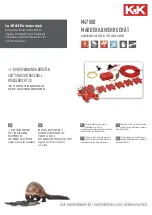
SETUP & OPERATON
HeatNet Control V3
Page 15
condensing boilers (Fusion-Series) when the return water
temperature is below 140F.
The return water temperature sensor would
need to be moved from the Master’s return
inlet to the system return. The
EXCHGR
DELTA
may need to be adjusted in
SETUP:
AUX FUNCTIONS: HEAT EXCHANGER
to prevent the Master from going to ½ input
when a high
DELTA T
is reached.
This method would lead to the non-condensing boilers
carrying the load when the system temperature stabilizes
above 140F, since non-condensing boilers will start first
with the Return water temperature is > 140F. The
condensing boilers can then be stopped first when the RET
water temperature is above the 140F. Remember, any
combination of the Start and Stop conditions may be applied
for best performance and economy in the system. Also, non-
condensing boilers may be set to go offline when a return
temperature is too low using the SETUP: AUX
FUNCTIONS: HET EXCHANGER: TEMP DISAB menu.
Base load boilers can also be mixed in the same way as
condensing and non-condensing boilers. The base load
boiler(s) can be prioritized in one set (example, Priority 2)
and non-base load boilers (Priority 1). The non-base load
boilers can then be set to fire first and once they are all
firing, the base load boiler would fire.
To minimize the cycling of a large base load boiler, consider
using the stop condition. Change it to the OAT < 15F
(Outside Air Temperature) condition. This setting may be
used to stop the Priority 1 boiler set when the OAT drops
below the OAT setpoint, thus leaving the large base loaded
boiler on and shutting off the condensing boilers first. This
is also true when using the OAT setting to start the
Priority 1 boiler set when the OAT is above the start
setpoint. To use temperatures as start and stop conditions,
the system design temperatures must be known.
Selecting Mixed Boilers
There are a few factors to consider when choosing which
type of boilers to use in a mixed system. These factors need
to be considered when boilers are added or shed. When
BTUs are introduced into the system by adding boilers, the
amount of introduced BTUs should be smooth (linear). If
these factors are not considered, discontinuity in BTUs may
occur when boilers are added and as a result, short cycling
will occur.
1.
Turndown
: This is the ratio of minimum fire rate to
maximum fire rate: Example: a 20% minimum
modulation = 5:1 turndown (100%mod / 20% mod). A
(1) million BTU boiler = 200,000 BTUs minimum
input.
2.
MOD MAX CLAMP
: This value determines the
maximum modulation % at which the boilers will fire
to, until all available boilers are firing.
3.
Total System BTUs
.
4.
Desired Effective Turndown
. This is the lowest
firing rate of the system relative to the maximum firing
rate of the system. The larger the value, the lower the
BTUs that can be delivered to a light load.
5.
Piping
.
Mixed System Type 1:
High System Turndown
The following examples are of mixed boiler systems with
high effective system turndown and fault tolerance built in.
When boiler types are the same, the system turndown is
limited to the boiler’s min input and fault tolerance is
always present. When the system has mixed boiler types,
consideration needs to be taken on what types can be mixed
properly to achieve a high system turndown and provide
some fault tolerance.
Fault tolerance allows for one boiler in the Priority 1 system
to fail and any boiler(s) in the Priority 2 system to fail and
still provide near linear (continuity) BTU response when
adding boilers. This is illustrated in the following examples
using the Boiler System Response graphs.
The Futera III/Fusion-Series Mixed Boiler System
(examples) is advantageous in providing low BTU input for
light loads and high BTUs for heavy loads. The effective
system turndown minimizes short cycling when light loads
are present by assigning smaller boilers to Priority 1,
running them first, and then stopping them last.
In order to achieve the high effective
turndown, smaller boilers are required
(plumbing considerations need to be
considered here due to differing flow/volume
characteristics through the large and small
boilers).
Example Systems:
Figure 4
Non-Mixed Boiler System
System
MMBTU
Effective
Turndown
MOD
MAX
MB/MW 4:1
10.0
20:1
70%
2000, 2000, 2000,
2000, 2000
5.0
20:1
70%
1000, 1000, 1000,
1000, 1000
2.5
20:1
70%
500, 500, 500, 500,
500
Summary of Contents for FUTERA XLF Series
Page 27: ...CONTROL METHODS HeatNet Control V3 Page 27 Figure 25 Base loading relay...
Page 67: ...WIRING CONNECTIONS HeatNet Control V3 Page 67 Figure 49 Jumper Dip Switch Locations...
Page 73: ...WIRING CONNECTIONS HeatNet Control V3 Page 73 Figure 57 Temperature sensors...
















































